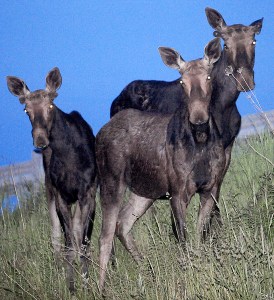RUMFORD — May and June are the peak months for moose-vehicle collisions, which is why two state agencies began alerting drivers on Thursday to the approaching danger.
As the weather warms, roadsides are one of the first places to turn green throughout Maine. After their winter diet, moose are hungry for salt, which can be found on the side of roads, and in tender green plants.
This brings them in close proximity to vehicles, Lee Kantar, state moose biologist for the Maine Department of Inland Fisheries and Wildlife, said Thursday afternoon.
“Given the size and mass of moose, the likelihood of serious personal injury is far greater with moose, and thus, it is absolutely critical for drivers to be constantly vigilant during this time of year,” Kantar said.
“Another problem is moose . . . especially young moose . . . who find themselves suddenly on their own because cows now have offspring,” Kantar said.
“Moose in May and June that get into the most trouble are likely yearlings that have been ‘kicked off’ from the mother, who has calved in May and likely has a calf at heel in June,” he said.
The most likely time for moose-vehicle collisions is from dusk until dawn. From 7 p.m. to midnight is when most occur, Kantar said, because moose move more during the evening after temperatures drop.
Every Maine county records moose-vehicle collisions, of which, almost 80 percent of crashes happen when it’s dark and nearly 90 percent occur between dusk and dawn, he said.
To minimize chances of colliding with moose, reduce speed after dark, use high beams whenever possible and buckle up.
“Moose are chocolate-brown in color, which makes them hard to see at night,” Kantar said. “And if you see one, be on guard — they tend to move in groups. If you should see one, slow down, don’t try to drive around it, and stay in your vehicle — you put yourself and others at risk.”
Due to the warm winter and lack of snow, deer have been out along roadsides already and getting hit, never having really been penned up in deer yards by heavy snowfall, Chuck Hulsey, state wildlife biologist of Strong, said.
Vegetation is also greening up earlier than usual, he said.
“I would say two weeks early, just around my yard, and that’s the kind of food they like when they first come out, those green succulents,” he said.

Comments are no longer available on this story